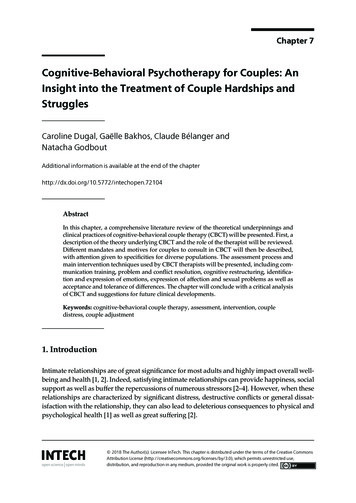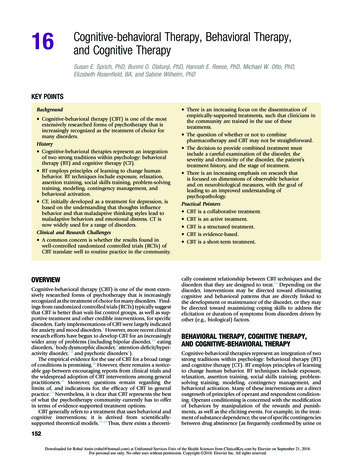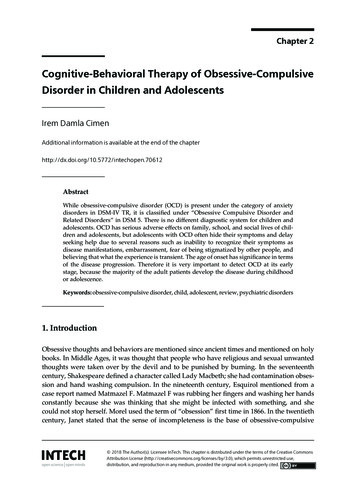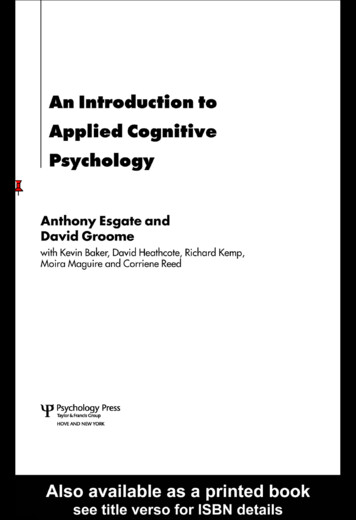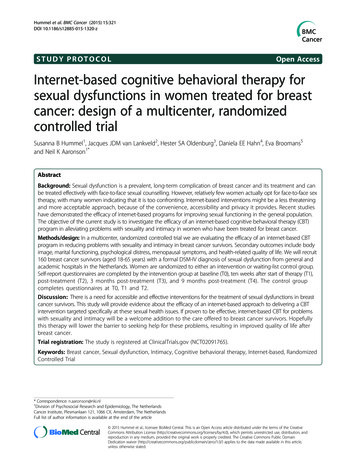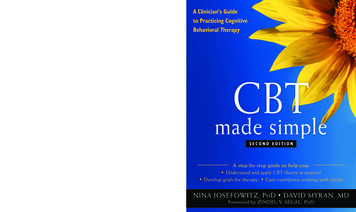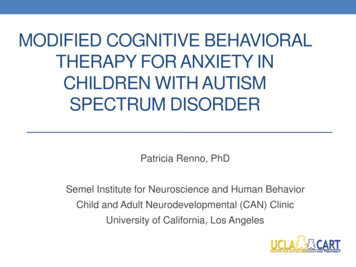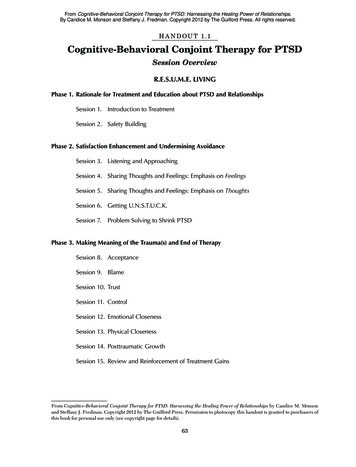
Transcription
From Cognitive-Behavioral Conjoint Therapy for PTSD: Harnessing the Healing Power of Relationships.By Candice M. Monson and Steffany J. Fredman. Copyright 2012 by The Guilford Press. All rights reserved.H andout 1 .1Cognitive-Behavioral Conjoint Therapy for PTSDSession OverviewR.E.S.U.M.E. LivingPhase 1. Rationale for Treatment and Education about PTSD and RelationshipsSession 1. Introduction to TreatmentSession 2. Safety BuildingPhase 2. Satisfaction Enhancement and Undermining AvoidanceSession 3. Listening and ApproachingSession 4. Sharing Thoughts and Feelings: Emphasis on FeelingsSession 5. Sharing Thoughts and Feelings: Emphasis on ThoughtsSession 6. Getting U.N.S.T.U.C.K.Session 7.Problem Solving to Shrink PTSDPhase 3. Making Meaning of the Trauma(s) and End of TherapySession 8. AcceptanceSession 9. BlameSession 10. TrustSession 11. ControlSession 12. Emotional ClosenessSession 13. Physical ClosenessSession 14. Posttraumatic GrowthSession 15. Review and Reinforcement of Treatment GainsFrom Cognitive- Behavioral Conjoint Therapy for PTSD: Harnessing the Healing Power of Relationships by Candice M. Monsonand Steffany J. Fredman. Copyright 2012 by The Guilford Press. Permission to photocopy this handout is granted to purchasers ofthis book for personal use only (see copyright page for details).63
H andout 1 . 2Cycle of PTSD Symptoms and Recoveryfrom TraumaCycle of PTSD AvoidanceNatural Recovery versus PTSD30PTSDNon-PTSDPTSD Severity2520151050123456 7Weeks8910 11 12From Cognitive- Behavioral Conjoint Therapy for PTSD: Harnessing the Healing Power of Relationships by Candice M. Monsonand Steffany J. Fredman. Copyright 2012 by The Guilford Press. Permission to photocopy this handout is granted to purchasers ofthis book for personal use only (see copyright page for details).64
H andout 1 . 3Treatment ContractTreatment Components—Three PhasesR Rationale for TreatmentE Education about PTSD and RelationshipsS Satisfaction EnhancementPhase 1Phase 2U Undermining AvoidanceM Making Meaning of the Trauma(s)E End of Therapy—commitment to ongoing bettermentPhase 3LivingTreatment Expectations1. Come to sessions as a couple2. Keep information within conjoint sessions3. Time limited4. Out-of-session assignments to apply skills5. Best foot forward6. Focus on improving both your relationship and PTSD7. Treatment targets: behavior and cognition(cont.)From Cognitive- Behavioral Conjoint Therapy for PTSD: Harnessing the Healing Power of Relationships by Candice M. Monsonand Steffany J. Fredman. Copyright 2012 by The Guilford Press. Permission to photocopy this handout is granted to purchasers ofthis book for personal use only (see copyright page for details).65
Treatment Contract (page 2 of 2)Our goals:What we will observe (behavioral):1. Improve our relationship2. Improve PTSD symptomsI have read and received information regarding the therapy we are undertaking together and commitoptimistically to myself and my partner to this and our goals listed above.PartnerDatePartnerDate66
H andout 1 . 4Trauma and RelationshipsExposure to a traumatic experience can cause both individual and relationship problems. Not all traumareactions are the same, and you or your loved ones’ reactions may be different from those of otherpeople. This handout discusses some of the widespread reactions survivors and their loved ones canhave after a traumatic event. You’ve been asked to read it together as a couple. As you review it, assessyour feelings, thoughts, and actions and how they may be different since the traumatic experience.PTSD as Impeded RecoveryA traumatic event exposes a person to a situation that is life-threatening or involves risk of bodily injuryto him- or herself or someone else. Intense feelings are natural reactions to being faced with this kindof threat. For many people, these feelings and reactions related to the trauma decrease over the weeksand months after the trauma is over. Feeling those natural feelings, getting support from others, facingthe memories and reminders of the trauma, and developing healthy thoughts about why the traumaoccurred help people recover naturally from their trauma. However, in the case of posttraumatic stressdisorder (PTSD), these feelings may persist because the person continues to think he or she is in danger,despite actually being physically safe.There are two major reasons people experience PTSD, and we specifically target these two reasons in the therapy.1. Thinking about the trauma. One reason people continue to have intense feelings and otherdifficulties in the wake of trauma is that they find it hard to make sense of the event and howor why it happened. This causes the trauma survivor to relive or reexperience the event in anattempt to understand and make sense of it. It is as if the person’s mind is trying to fit the piecesof a puzzle together but hasn’t quite figured out how to do this. As a result of constantly relivingthe event, it makes the person feel as if the trauma is still happening. When reminded of theevent, the person feels the same feelings he or she felt at the time of the event, and this causeshim or her to feel unsafe in the present. Many things can trigger or prompt these memories andreactions to them—certain places, times of day, smells, sounds, people, emotions, and bodilysensations. Partners or other family members can also serve as triggers, particularly if the traumatic event was at the hands of another person (e.g., rape, robbery, combat).2. Avoiding and numbing. The second reason people have PTSD is that they avoid those reminders and their feelings, which makes them feel better in the short run but has the negative consequences in the long run of maintaining the cycle of symptoms. In the long run, they do not getthe opportunity to learn that these reminders and feelings do not necessarily signal danger.Symptoms of PTSD and RelationshipsPTSD consists of four different clusters of symptoms that feed off of one another to keep you stuck withthe symptoms and relationship difficulties.(cont.)From Cognitive- Behavioral Conjoint Therapy for PTSD: Harnessing the Healing Power of Relationships by Candice M. Monsonand Steffany J. Fredman. Copyright 2012 by The Guilford Press. Permission to photocopy this handout is granted to purchasers ofthis book for personal use only (see copyright page for details).67
Trauma and Relationships (page 2 of 3)Reexperiencing SymptomsThe reexperiencing symptoms of PTSD can take the form of unwanted or intrusive thoughts about thetrauma, some of which can interfere with attention and concentration. In addition to fear, these memories can be associated with other negative emotions, such as anger, sadness, shame, and intense physiological reactions, such as racing heart, sweating, nausea, or stomach upset. Partners sometimes thinkthe traumatized individual is not interested in or paying attention to what he or she is saying when, infact, the person may be distracted by trauma memories and the distress associated with them. Traumasurvivors can also have flashbacks or vivid images, leaving them feeling as if they are back in the event.Partners may try to cover up or explain away this reaction if the flashback occurs when other peopleare around. Bad dreams about the trauma are also common, and couples may find it hard to sleep inthe same bed due to the traumatized individual’s disturbed sleep and restlessness.Hyperarousal SymptomsAs a result of feeling like he or she is constantly reliving the event, the trauma survivor’s fight-or-flightresponse is chronically activated. We are evolutionally wired to fight or flee our way out of a situationthat is truly dangerous in the moment, and then when we are no longer in danger, for the fight-or-flightresponse to turn off, like a light switch. However, in the case of PTSD, it is as though the light switch ison all the time with the trauma survivor feeling as if the trauma is still happening or that something badis going to happen again. Being chronically in the fight-or-flight mode results in the hyperarousal (i.e.,overaroused) symptoms of PTSD. These symptoms include anger and irritability, which can erode happiness in intimate relationships. Partners may sometimes feel they are “walking on eggshells” to avoidthe traumatized individual becoming angry or agitated. As a result, couples and family members mayfind it hard to communicate, particularly when there are differences of opinions or preferences. Verbaland physical aggression have also been associated with these symptoms.Other symptoms of hyperarousal include trouble sleeping, concentration problems, being easilystartled, and being super-alert or hypervigilant. Traumatized individuals are hypervigilant to protectthemselves and their loved ones from perceived danger, and this can take many forms. For instance, tobe able to scan the environment for threat and keep himself and others safe, the trauma survivor maytry to sit with his back to the wall rather than the door, frequently check door locks, sleep with the lightson, patrol the perimeter of the house for intruders, or call loved ones multiple times in a row to makesure that nothing bad has happened to them. This hypervigilance for threat can also extend to lovedones to the extent that the trauma survivor perceives the partner as critical or negative even though thepartner does not feel this way. For example, leaving socks on the floor can be interpreted as a sign ofdisrespect or asking a question about why the trauma survivor was late for dinner could be interpretedas an accusation of infidelity.Behavioral AvoidanceBecause it is unpleasant to reexperience a traumatic event and the hyperarousal that goes with the distressing memories, it is understandable that traumatized individuals might use a variety of strategies tofeel better in the moment. One strategy is avoidance. Individuals with PTSD seek to avoid reminders ofthe traumatic event in their environment (such as people, places or things) and to avoid the unpleasantfeelings associated with the event (e.g., anxiety, sadness, anger, guilt, shame). There also tends to beavoidance of thoughts and feelings associated with the reminders as well. Individuals with PTSD canavoid in many ways, including alcohol and drugs, sex, overworking, gambling, self-harm behaviors,and suicidal thinking. In an effort to be supportive, loved ones may try to protect or buffer traumatized(cont.)68
Trauma and Relationships (page 3 of 3)individuals from situations that make them feel anxious or otherwise uncomfortable, and couples mayadapt their relationship to minimize the traumatized individual’s discomfort. For example, as a couple,they may not do activities that involve being around groups of people or in open spaces because thetraumatized individual feels exposed and vulnerable.Emotional NumbingEmotional numbing is another way people who have been traumatized decrease the distress associated with trauma reminders. When people have been exposed to a traumatic event and feel extremelyafraid, helpless, or horrified, they can feel overwhelmed and, to cope, disconnect from their feelings totemporarily decrease their intensity. Numbing is related to the freeze response, which occurs when theindividual is in a life-threatening or otherwise intensely frightening situation and cannot fight or flee hisor her way out of it. As a way of surviving, the body protectively becomes still and “hunkers down” foranticipated injury. In the case of PTSD, disconnecting from one’s feelings becomes a general strategyto cope with a variety of stressful or uncomfortable situations so the individual can feel less anxious ordistressed in the moment. In many cases, the emotional numbing happens almost automatically, andthe traumatized individual may not even be aware that he or she is doing it.Emotional numbing symptoms include difficulty feeling a range of emotions, both negative (e.g.,anxiety, sadness, anger) and positive (e.g., joy, love). It is also seen through loss of interest in activities and people and feeling distant or cut off from others. Emotional numbing is particularly hard onintimate relationships because emotions serve as the “glue” that bonds people together. Emotions helpcouples feel close and connected to one another, and when they are not shared, partners can feeldistant and disconnected.Avoidance and numbing can contribute to problems with sexual relationships after a trauma.Sex, physical intimacy, and feeling vulnerable with another person more generally may be a traumareminder and increase the urge to avoid or feel numb. Emotional numbing can contribute to difficulties feeling sexually interested due to lack of desire and difficulty feeling positive feelings, regardless ofwhether the trauma was sexual in nature. Physical closeness (sexual intimacy and physical affectionmore generally) is one way partners feel close to one another. When physical contact is uncomfortableor distressing for at least one person, couples may feel distant or cut off from one another.Other Trauma-Related Problems and RelationshipsOther problems that can occur after a trauma include guilt, shame, and depression. Trauma survivorssometimes feel guilty about or ashamed of things that they did or did not do at the time of the eventand think negative thoughts about themselves, including thoughts that they can’t trust themselves. Theymay also have trouble trusting other people, which can get in the way of feeling close to others. Negative thoughts about oneself and others can contribute to depression. When people are depressed, theyfeel sad and may lose interest in things that they used to enjoy or think were important, including work,hobbies, or spending time with loved ones. Sometimes, the depression can contribute to people thinking life isn’t worth living and that they would be better off dead. These kinds of thoughts may functionlike avoidance in that they provide a way for the person to minimize his or her distress in the momentby thinking of death as an escape from the current pain and suffering. At times, a couple’s relationship may be affected as well because the traumatized individual has withdrawn and the couple is notengaged in doing things as a couple.69
H andout 1 . 5Trauma Impact Questions–IName:1. How has trauma or PTSD affected our relationship to date? How has it impacted my thoughts,feelings, and behaviors about our relationship?2. Why did the traumatic event(s) happen to me or my partner?(cont.)From Cognitive- Behavioral Conjoint Therapy for PTSD: Harnessing the Healing Power of Relationships by Candice M. Monsonand Steffany J. Fredman. Copyright 2012 by The Guilford Press. Permission to photocopy this handout is granted to purchasers ofthis book for personal use only (see copyright page for details).70
Trauma Impact Questions–I (page 2 of 2)3. What do I believe in each of the following areas, as it relates to me, my partner, and others?Trust:Control:Emotional Closeness:Physical Closeness:71
H andout 1 . 6Out-of-Session AssignmentsSession 1. Introduction to Treatment1. Review the Cycle of PTSD Symptoms and Recovery from Trauma (Handout 1.2) together prior tothe next session.2. Read the Trauma and Relationships (Handout 1.4) together at least once prior to the next session.3. Each of you should complete the Trauma Impact Questions–I (Handout 1.5).4. Each day, catch your partner doing something nice, and let him or her know that you have noticedthis positive attitude and/or behavior. Place this form in an obvious place for the two of you andrecord on the form what you have noticed each day. Bring this form with you to the next session.Next appointment:@.You’ve Been Caught Doing Something NiceWeek of:Person Caught:Person aturdayFrom Cognitive- Behavioral Conjoint Therapy for PTSD: Harnessing the Healing Power of Relationships by Candice M. Monsonand Steffany J. Fredman. Copyright 2012 by The Guilford Press. Permission to photocopy this handout is granted to purchasers ofthis book for personal use only (see copyright page for details).72
H andout 2 .1Learning about AngerName:Situation about which I was angry:What were the earliest signs that I was angry?What did I do to increase or decrease my anger (e.g., breathing)?MY PARTNER’S ANGERWhat are the earliest signs that my partner is angry?From Cognitive- Behavioral Conjoint Therapy for PTSD: Harnessing the Healing Power of Relationships by Candice M. Monsonand Steffany J. Fredman. Copyright 2012 by The Guilford Press. Permission to photocopy this handout is granted to purchasers ofthis book for personal use only (see copyright page for details).87
H andout 2 . 2Steps to an Effective Time-OutS Self1. What is the level of your own distress?(0 none 10 as intense as you can imagine)5–6 yellow light7–8 red light2. Time-outs are for your sake.Feedback loopT Time-Out1. Nonverbal and verbal indication.2. Immediate stop in communication.3. Agree on an amount of time and circumstance for returning.O Outlet1. BREATHE.2. Avoid activities that fuel your negative emotions.3. Clarify what one or two things are most upsetting.4. Consider one thing you can do to improve communication.P Process1. Return at the agreed-upon time and circumstance.2. Resume communication, with focus on your goal for improvement. REMEMBER: TIMEOUT IS ONLY AS GOOD AS TIME-IN.3. Self-monitor.Time-Out Caller Circumstances What WorkedSherryWe werefighting overhow we spendour money. Idid not wantTom to buymore clothes.Areas to Improve Stopped fighting when time- We developedout was called.“ammunition” while we We came back at the timewere apart.we agreed upon. We didn’t focus on We called a second timeimproving our ownout.communication.From Cognitive- Behavioral Conjoint Therapy for PTSD: Harnessing the Healing Power of Relationships by Candice M. Monsonand Steffany J. Fredman. Copyright 2012 by The Guilford Press. Permission to photocopy this handout is granted to purchasers ofthis book for personal use only (see copyright page for details).88
H andout 3 .1PTSD and AvoidanceAs we discussed in the session, many people who have experienced trauma try to avoid thoughts andfeelings associated with that event. Similarly, many people also avoid situations, places, and activities that remind them of the trauma or because they feel scary. People with PTSD can also becomefrightened of the thoughts, feelings, and physical sensations associated with emotions. This tendencyhas been described as a “fear of feeling.” Although avoiding can make you feel more comfortable inthe short run, it actually can make the problem worse in the long run because it prevents you fromovercoming your oidanceCertainsoundsLike avoiding situations, places, and activities that remind them of traumas, people with PTSDcome to avoid their own internal experiences, such as their thoughts, feelings, and physical sensations.We sometimes describe this as a fear of feeling. Techniques to avoid your inner experience mightinclude being over-busy, thinking obsessively, numbing your emotions, overcontrolling your emotionsfor fear of being out of control, or injuring yourself to distract from painful emotions.When you confront feared conversations, memories, situations, or feelings, several things begin tohappen. Facing these situations helps you make sense of them (e.g., Why am I afraid to talk to my spouseabout our children? She might figure out that I don’t feel like I’m an adequate parent). You learn that thinking about these experiences is not dangerous and that being upset or anxious is not dangerous (e.g., I won’t go crazy if I’m sad after talking about these situations. In fact,my partner and I feel closer). You become less fearful of other situations that remind you of these situations (e.g., Now thatI’ve faced this and had a positive experience, why wouldn’t that be the case in the future?). You learn that you can handle your fear and anxiety and, therefore, you feel better about yourself (e.g., I’m strong enough to handle being sad or angry without acting on these feelings. I don’thave to feel good all of the time, but rather be good at feeling). You learn that when you repeatedly confront memories or situations you have avoided, thefear and distress gradually decrease. In other words, you again become relatively comfortablein these situations (e.g., I don’t get nearly as upset as I used to discussing these things with mypartner).Choosing to address more directly difficult issues for yourself and your relationship is hard work inthe short term but will lead to long-term payoff.From Cognitive- Behavioral Conjoint Therapy for PTSD: Harnessing the Healing Power of Relationships by Candice M. Monsonand Steffany J. Fredman. Copyright 2012 by The Guilford Press. Permission to photocopy this handout is granted to purchasers ofthis book for personal use only (see copyright page for details).102
H andout 3 . 2Avoidance ListList below as many things as possible that you, as a couple or individually, avoid but wouldapproach if PTSD took up less space in your relationship.PlacesSituationsPeopleFeelingsFrom Cognitive- Behavioral Conjoint Therapy for PTSD: Harnessing the Healing Power of Relationships by Candice M. Monsonand Steffany J. Fredman. Copyright 2012 by The Guilford Press. Permission to photocopy this handout is granted to purchasers ofthis book for personal use only (see copyright page for details).103
H andout 3 . 3Out-of-Session AssignmentsSession 3. Listening and Approaching1. Continue to watch for, and point out, positive behaviors in each other.2. Read over the PTSD and Avoidance (Handout 3.1) together prior to your next session.3. Together, continue to write down things on the Avoidance List (Handout 3.2) that we started intoday’s session that you seem to avoid in your day-to-day life. This list will be used in the rest ofthe therapy.4. Each day prior to the next session, spend 5 minutes communicating with one another usingyour best paraphrasing skills. Each of you should notice if the other paraphrased in yourcommunication. If so, place a checkmark in that person’s column or write down the content of hisor her paraphrasing. Put this form somewhere obvious for the two of you as a reminder to practicethe skill in your day-to-day life.Next appointment:@.Catch Each Other ParaphrasingWeek of:Person Caught:Example:Person Caught: concerns at rdayFrom Cognitive- Behavioral Conjoint Therapy for PTSD: Harnessing the Healing Power of Relationships by Candice M. Monsonand Steffany J. Fredman. Copyright 2012 by The Guilford Press. Permission to photocopy this handout is granted to purchasers ofthis book for personal use only (see copyright page for details).104
H andout 4 .1Communication ChannelsChannel CheckWhat is the goalof the conversation?SharingThoughtsand FeelingsProblemSolvingThe first step in effective communication is to check your channels. Knowing about the different channels of communication can help you determine the goal of the conversation. What channel are youon? Do you want to solve a problem, or do you want to share about it? What channel is your partneron? Are you on the same channel? As partners, you will have greater understanding of one another andmore satisfaction in your communication if you become aware of what the difference is between thechannels and notice the channels each of you are on. For instance, one partner may be on the sharingchannel and wants to be understood rather than to work out the details of problem solving. Or onepartner is on the problem-solving channel and is eager to resolve a particular issue. When couplesare on different channels—that is, when one person is on the solving channel and the other is on thesharing channel—conflict, confusion, and miscommunication can result. Checking in to see whichchannels you are on can open the door to understanding, intimacy, empathy, and improved conflictresolution.From Cognitive- Behavioral Conjoint Therapy for PTSD: Harnessing the Healing Power of Relationships by Candice M. Monsonand Steffany J. Fredman. Copyright 2012 by The Guilford Press. Permission to photocopy this handout is granted to purchasers ofthis book for personal use only (see copyright page for details).114
H andout 4 . 2Identifying 50 100Madirritated annoyed angry hostile ragefulUnfairnessSaddown glum depressed miserable despondentLosscautious apprehensive anxious terrifiedDangerDisgusteda little turned off appalled revoltedContamination/violationAshamedembarrassed disgraced humiliated mortifiedSelf as badcontented pleased happy delighted ecstaticSelf, others, or worldas positivescared disgustedDanger Contaminationmad scaredUnfairness Dangermad sadUnfairness LossScaredGladHorrifiedJealousDisappointedFrom Cognitive- Behavioral Conjoint Therapy for PTSD: Harnessing the Healing Power of Relationships by Candice M. Monsonand Steffany J. Fredman. Copyright 2012 by The Guilford Press. Permission to photocopy this handout is granted to purchasers ofthis book for personal use only (see copyright page for details).115
H andout 4 . 3PROUD to Shrink PTSDGetting the Most Out of Your Approach TasksP PLANNEDApproach tasks should be planned. Decide in advance what you will approach. Plan together inadvance when you will complete your practice assignment and put it in your schedule. Have a backupplan in case the original plan doesn’t work out.R REPEAT, REPEAT, REPEATSuccessful approach tasks are repeated frequently. The more you approach what you have avoided, themore you will learn. It is a good idea to practice being in the same situation repeatedly until it becomeseasier.O OBSTACLESRemove obstacles to your new learning. Sometimes people will put themselves in approach situations,but find ways to avoid during them and, therefore, not learn. You may distract yourself, drink alcoholor use drugs, rely on your partner or children to help you through the situation, or “white knuckle”through the experience (i.e., just getting through the situation without really being there). Try to avoiddoing anything that might prevent your new learning!U UNCOMFORTABLEExpect to feel uncomfortable. It is perfectly normal to feel distressed while you are doing approachassignments. This is why they are on the approach list! Success should not be judged by how you feltin the situation. Rather, success should be judged by whether you were able to feel your feelings andstay in the situation.D DECREASE DISTRESSStay in the situation until your distress decreases. In order for you to learn new information from yourexperiences, it is very important for you to stay in the situation long enough to learn from it. Yourdistress is not likely to completely subside, but stay in the situation as long as you can to notice itdecrease.From Cognitive- Behavioral Conjoint Therapy for PTSD: Harnessing the Healing Power of Relationships by Candice M. Monsonand Steffany J. Fredman. Copyright 2012 by The Guilford Press. Permission to photocopy this handout is granted to purchasers ofthis book for personal use only (see copyright page for details).116
H andout 4 . 4Out-of-Session AssignmentsSession 4. Sharing Thoughts and Feelings: Emphasis on Feelings1. Continue to watch for, and point out, positive behaviors in each other.2. Each of you practices a channel check at least once prior to the next session.3. At least one time per day, catch your partner sharing a feeling. Record the feeling “caught” below.You may need to ask how he or she is feeling in order to catch a feeling.4. Shrinking PTSD through Approach:(people, place, situation, feeling)Write about how it went:Place this form somewhere that is convenient and visible to the two of you.Next appointment:@.Catch Your Partner’s FeelingsWeek MondayTuesdayWednesdayThursdayFridaySaturdayFrom Cognitive- Behavioral Conjoint Therapy for PTSD: Harnessing the Healing Power of Relationships by Candice M. Monsonand Steffany J. Fredman. Copyright 2012 by The Guilford Press. Permission to photocopy this handout is granted to purchasers ofthis book for personal use only (see copyright page for details).117
H andout 5 .1Sharing Thoughts and Feelings to Shrink PTSDAs we discussed in today’s session, what we feel and how we act are highly dependent on what wethink. Our perceptions are very important. This is true for everyone, whether traumatized or not. Youhave probably had the experience of being in the same situation with other people only to find thatthey have a completely different story about the situation than you do. This happens because eachperson perceives differently. People organize what they see and hear into their own understanding ofthe situation.Event ll behaviors l consequences ( /–)(emotions)When an event occurs, there are thoughts or interpretations about that event. The way that youperceive or think about a situation influences feelings and behaviors. In this way, thoughts lead to feelings and actions. Sometimes, though, our thoughts are so automatic that we don’t even realize thata thought came before our feeling or our action. Even though you may not be aware of what you arethinking or saying to yourself, your thoughts and self-talk affect your mood and your behavior. The goalof this therapy is to begin to recognize those automatic thoughts, to share them with your partner, andto notice how they make you feel and act.Let’s take an example. If someone with PTSD does not want to go somewhere (e.g., the movies) because he has the thought, “It’s an open, dangerous place,” he would likely have the feeling
Phase 3. Making Meaning of the Trauma(s) and End of Therapy Session 8. Acceptance Session 9. Blame Session 10. Trust Session 11. Control Session 12. Emotional Closeness Session 13. Physical Closeness Session 14. Posttraumatic Growth Session 15. Review and Reinforcement of Treatment Gains HANDOUT 1.1 Cogni


